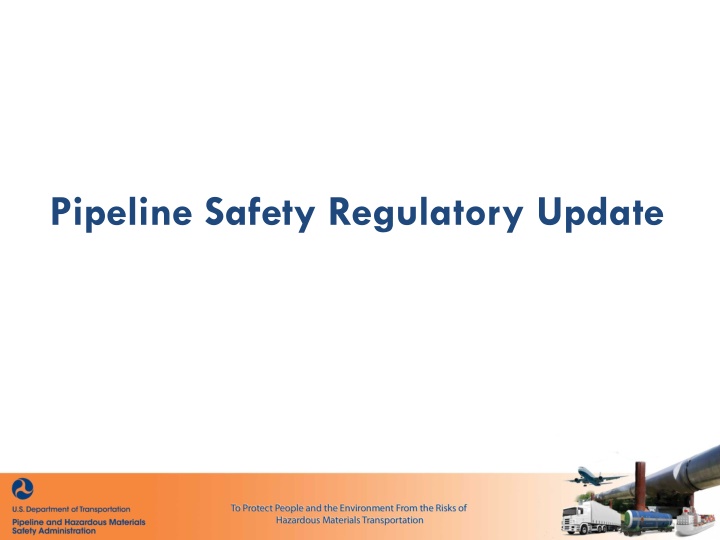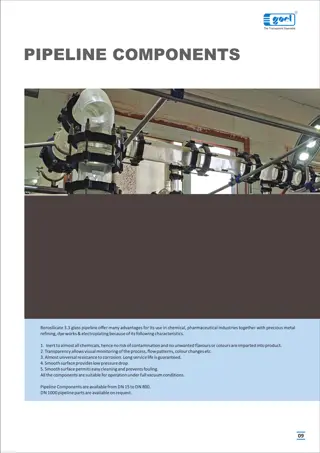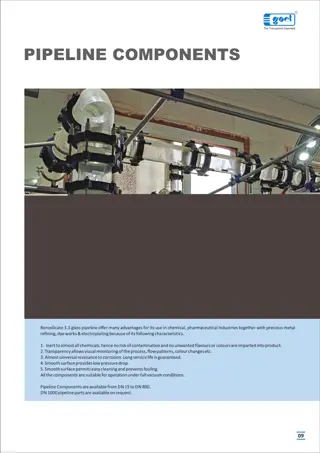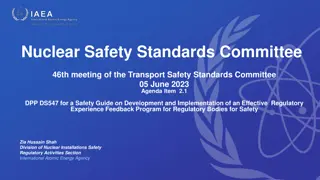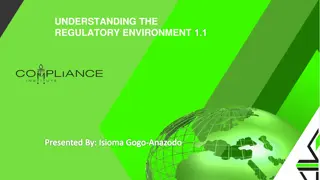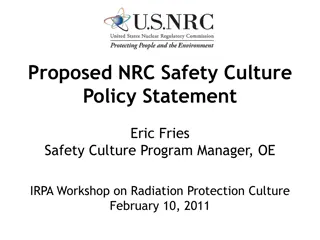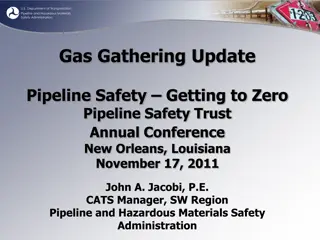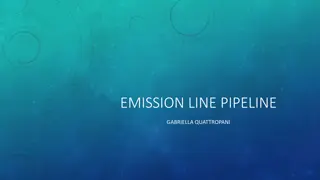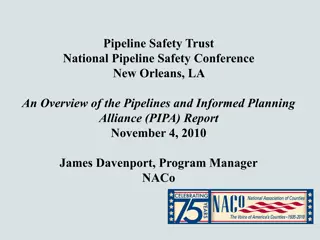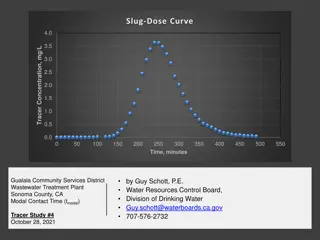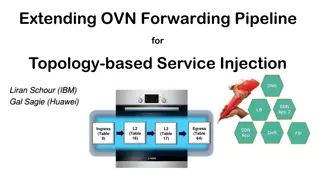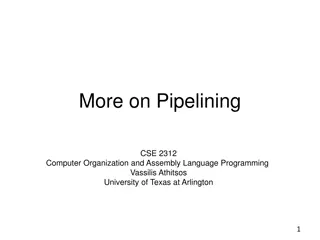Overview of Pipeline Safety Regulatory Updates
The Protecting our Infrastructure of Pipelines and Enhancing Safety Act of 2016 authorizes funding for PHMSA. Information on rulemakings can be found in DOT reports. The timeline for future rulemaking is pending on implementing Executive Orders. Enforcing the Regulatory Reform Agenda aims to alleviate regulatory burdens. Agencies are required to establish Regulatory Reform Task Forces for recommendations. The EO 13771 directs agencies to reduce regulations and control regulatory costs through budgeting processes.
Download Presentation

Please find below an Image/Link to download the presentation.
The content on the website is provided AS IS for your information and personal use only. It may not be sold, licensed, or shared on other websites without obtaining consent from the author.If you encounter any issues during the download, it is possible that the publisher has removed the file from their server.
You are allowed to download the files provided on this website for personal or commercial use, subject to the condition that they are used lawfully. All files are the property of their respective owners.
The content on the website is provided AS IS for your information and personal use only. It may not be sold, licensed, or shared on other websites without obtaining consent from the author.
E N D
Presentation Transcript
The Protecting our Infrastructure of Pipelines and Enhancing Safety (PIPES) Act of 2016, was passed by Congress and signed into law on June 22, 2016 It authorizes funding for PHMSA from 2016 to 2019 https://www.phmsa.dot.gov/pipes-act
Where can I find information on the Status of Significant rulemakings? DOT Report on DOT Significant Rulemakings (Monthly reports) http://www.dot.gov/regulations/report-on-significant- rulemakings OMB www.reginfo.gov - 5 -
The timeline for all future rulemaking is pending Departmental determinations on implementing and maintaining compliance with the applicable Executive Orders and Memorandums.
Enforcing the Regulatory Reform Agenda 1/24 (EO 13766) The EO states it is the policy of the United States is to alleviate unnecessary regulatory burdens placed on the American people. The order requires the head of each agency to designate an agency official as its Regulatory Reform Officer (RRO). https://www.federalregister.gov/documents/2017/01/30/2017- 02029/expediting-environmental-reviews-and-approvals-for-high- priority-infrastructure-projects - 9 -
Enforcing the Regulatory Reform Agenda 1/24 The Regulatory Reform Officer will oversee the implementation of regulatory reform initiatives and policies to ensure that agencies effectively carry out regulatory reforms, consistent with applicable law. - 10 -
Enforcing the Regulatory Reform Agenda 1/24 Each agency must also establish a Regulatory Reform Task Force responsible for making recommendations regarding the repeal, replacement or modification of existing regulations. - 11 -
Reducing Regulation and Controlling Regulatory Costs 1/30 (EO 13771) The EO directs agencies to identify for elimination at least two prior regulations for every one new regulation that is issued and to prudently manage and control the cost of planned regulations through a budgeting process. The EO requires that the total incremental cost of all new regulations finalized in FY 2017, including repealed regulations, shall be no greater than zero, unless https://www.federalregister.gov/documents/2017/02/03/2017- 02451/reducing-regulation-and-controlling-regulatory-costs - 12 -
Reducing Regulation and Controlling Regulatory Costs 1/30 During the Presidential budget process, the Director of OMB shall identify to agencies a total amount of incremental costs that will be allowed for each agency in issuing new regulations and repealing regulations for the next fiscal year. No regulations exceeding the agency's total incremental cost allowance will be permitted in that fiscal year, unless required by law or approved in writing by the Director. - 13 -
Executive Order on a Comprehensive Plan for Reorganizing the Executive Branch 3/13 (EO 13781) directing the Director of the Office of Management and Budget (Director) to propose a plan to reorganize governmental functions and eliminate unnecessary agencies (as defined in section 551(1) of title 5, United States Code), components of agencies, and agency programs. the Director shall consider, in addition to any other relevant factors: https://www.federalregister.gov/documents/2017/03/16/2017- 05399/comprehensive-plan-for-reorganizing-the-executive-branch - 14 -
Executive Order on a Comprehensive Plan for Reorganizing the Executive Branch 3/13 (i) whether some or all of the functions of an agency, a component, or a program are appropriate for the Federal Government or would be better left to State or local governments or to the private sector through free enterprise; (ii) whether some or all of the functions of an agency, a component, or a program are redundant, including with those of another agency, component, or program; - 15 -
Executive Order on a Comprehensive Plan for Reorganizing the Executive Branch 3/13 (iii) whether certain administrative capabilities necessary for operating an agency, a component, or a program are redundant with those of another agency, component, or program; (iv) whether the costs of continuing to operate an agency, a component, or a program are justified by the public benefits it provides; and (v) the costs of shutting down or merging agencies, components, or programs, including the costs of addressing the equities of affected agency staff. - 16 -
Promoting Energy Independence and Economic Growth 3/28 (EO 13783) It is in the national interest to promote clean and safe development of our Nation's vast energy resources, while at the same time avoiding regulatory burdens that unnecessarily encumber energy production, constrain economic growth, and prevent job creation. https://www.federalregister.gov/documents/2017/03/31/2017- 06576/promoting-energy-independence-and-economic-growth - 17 -
Promoting Energy Independence and Economic Growth 3/28 Executive departments and agencies immediately review existing regulations that potentially burden the development or use of domestically produced energy resources and appropriately suspend, revise, or rescind those that unduly burden the development of domestic energy resources beyond the degree necessary to protect the public interest or otherwise comply with the law. - 18 -
Promoting Energy Independence and Economic Growth 3/28 Section 2 directs immediate review of all agency actions that potentially burden the Safe, Efficient Development of Domestic Energy Resources, with specified deadlines. Such review shall not include agency actions that are mandated by law, necessary for the public interest, and consistent with the policy set forth in section 1. Section 2(b) states that "burden" means to unnecessarily obstruct, delay, curtail, or otherwise impose significant costs on the siting, permitting, production, utilization, transmission, or delivery of energy resources. - 19 -
The following PHMSA regulatory updates are simply an overview Details can be found in the Federal Register postings
Interim Final Rule Safety of Underground Natural Gas Storage Facilities Docket No: PHMSA-2016-0016 https://www.federalregister.gov/documents/2016/12/19/2016- 30045/pipeline-safety-safety-of-underground-natural-gas- storage-facilities
One of the largest natural gas releases in U.S. history 4-month-long blowout 5.4 BCF released (CARB) 8 MMT C02 equivalent 20% increase to statewide CH4 emissions Alleged public health impacts FLIR video of release Environmental Defense Fund
Statutory Mandate: Pl 114-183, Section 13 The Secretary shall issue minimum safety standards for underground natural gas storage facilities within 2 years Considerations Consensus standards Economic impacts on gas consumers and end users Findings of the Aliso Canyon task force
Publication Date: December 19, 2016 Effective Date: January 18, 2017
Reporting requirements Incorporates by reference API RP 1170, Design and Operation of Solution- mined Salt Caverns used for Natural Gas Storage (July 2015), and API RP 1171, Functional Integrity of Natural Gas Storage in Depleted Hydrocarbon Reservoirs and Aquifer Reservoirs (September 2015).
Requires Operators of UNGS Facilities to: Implement construction, maintenance, risk- management, and integrity-management procedures for all UNGS Facilities.
Procedures for newly constructed and existing UNGS facilities that include design, construction, material, testing, commissioning, reservoir monitoring, and recordkeeping. operations, maintenance, threat identification, monitoring, assessment, site security, emergency response and preparedness, training, and recordkeeping.
Four types of reports are required from operators for underground natural gas storage facilities: Annual reports Incident reports Safety-related condition reports National Registry information
UNGSF should submit the first annual report form for the 2017 calendar year by March 15, 2018 (originally July 18, 2017) https://www.phmsa.dot.gov/underground-storage-annual-report- submission-extension
Emergency Order Authority Effective Date: October 14, 2016 Required by Section 16 of the PIPES Act Establishes temporary emergency order procedures to address unsafe conditions or practices imposing an imminent hazard Augments PHMSA s existing enforcement authority (e.g. Corrective Action Order, Safety Orders) https://www.phmsa.dot.gov/regulations-fr/rulemaking/2016-24788 - 30 -
Expands enforcement authority to address imminent safety hazards that exist across a subset or larger group of owners and operators. Applies only when PHMSA determines that an unsafe condition or practice is causing an imminent hazard.
Provides PHMSA authority to issue an emergency order without advance notice or opportunity for a hearing. Applies only to the extent necessary to abate the imminent hazard.
Key Dates Publication Date: July 23, 2015 Effective Date: January 1, 2016 Docket No. PHMSA-2009-0192 https://www.federalregister.gov/documents/2012/05/30/2012- 13025/pipeline-safety-pipeline-damage-prevention-programs 33
The final rule creates: Part 198, Subpart D Criteria for adequate state damage prevention enforcement programs and process for assessment Administrative procedures for states to contest a notice of inadequacy 34
New Part 196 Standards for excavators digging near pipelines Adjudication process for excavators cited by PHMSA Same as for operators cited by PHMSA for violations of pipeline safety regulations 35
The preamble outlines two policies: How the state program evaluation criteria will be applied How the excavator enforcement standard will be applied The policies are not part of the rule; they are flexible and can evolve as the rule is implemented 36
Call 811 before excavating Wait for pipeline operators to establish and mark the location of underground pipelines before excavating Excavate with proper regard for the marks, take all practicable steps to prevent excavation damage Make additional use of one-call as necessary 37
Any contact with pipelines must be reported to operator at earliest practical moment If there is a release, excavator must call 911 NOTE: There are no exemptions in the rule. PHMSA will be considerate of exemptions in state laws when undertaking Federal enforcement action. 38
Operator Qualification, Cost Recovery, Accident and Incident Notification, and Other Changes Docket: PHMSA-2013-0163 https://www.phmsa.dot.gov/regulations-fr/rulemaking/2016-31461
Many provisions related to OQ were discussed in the NPRM but were not carried through to the final rule. However, the Agency may decide to initiate a rulemaking re-proposing similar provisions at a later date.
Publication Date: January 23, 2017 Effective Date: March 24, 2017
Specifies an operators accident and incident reporting time to within 1 hour. Sets up a cost recovery fee structure for design review of new gas and hazardous liquid pipelines. Provides a renewal procedure for expiring special permits.
Requires operator to contact NRC within 48 hours to revise or confirm the initial telephone report Amount of product lost Estimate number of fatalities and injuries Known significant facts that are relevant to the cause of the incident or extent of damage If there is no change from original report, the operator must confirm
Excludes farm taps from the DIMP requirements, but adds regulator and overpressure testing requirements. Requiring pipeline operators to report to PHMSA a change in product (e.g., from liquid to gas, from crude oil to highly volatile liquids (HVL)) or a permanent reversal of flow that lasts more than 30 days.
Requires electronic reporting of drug and alcohol testing results in part 199, and modifying the criteria used to make decisions about conducting post accident drug and alcohol tests. Adds a procedure to request PHMSA keep submitted information confidential.
Adds reference to Appendix B of API 1104 related to in-service welding in parts 192 and 195. Provides methods for assessment tool selection by incorporating consensus standards by reference in part 195 for stress corrosion cracking direct assessment.
Develops and clarifies requirements for team training of control center staff involved in pipeline operational decisions. Develops requirements for team training of control center staff involved in pipeline operations similar to those used in other transportation modes.
Excess Flow Valves (EFV) for Multi- Residential and Commercial Applications Docket No. PHMSA-2011-0009 https://www.phmsa.dot.gov/regulations-fr/rulemaking/2011-30330
Publication Date: October 14, 2016 Effective Date: April 14, 2017
Between 1970 and 2001, NTSB issued more than 10 recommendations that dealt with using/installing excess flow valves (EFV) The most recent NTSB Safety Recommendation on EFVs, P-01-2, is addressed in this rulemaking In the past, mandatory EFV installation was not supported:
EFVs were perceived as unreliable Concerns about unintentional EFV closure, causing pilot burners to go off Potential cost to relight all pilots & deal with public complaints
Operators believed EFVs interfered with O&M activities Concerns that frozen moisture can block EFV s small opening in winter Cost/benefit numbers were too high Limited availability of large volume EFVs Difficult to size at varying loads Do not work below 10 psig
192.383(b) Operators must install an EFV on new or replaced service lines that: Branch to an Single Family Residence Serve multifamily residences where the known load is 1,000 SCFH Serve single, small commercial customers where the known load is 1,000 SCFH Exceptions: < 10 psig, contaminants in gas stream, interference with O&M activities, EFV unavailable
192.383(d) Existing customers have a right to request EFV installation 192.383(e) Operators must notify customers of their right to request EFVs & this notice must be available for PHMSA inspection (cont.)
